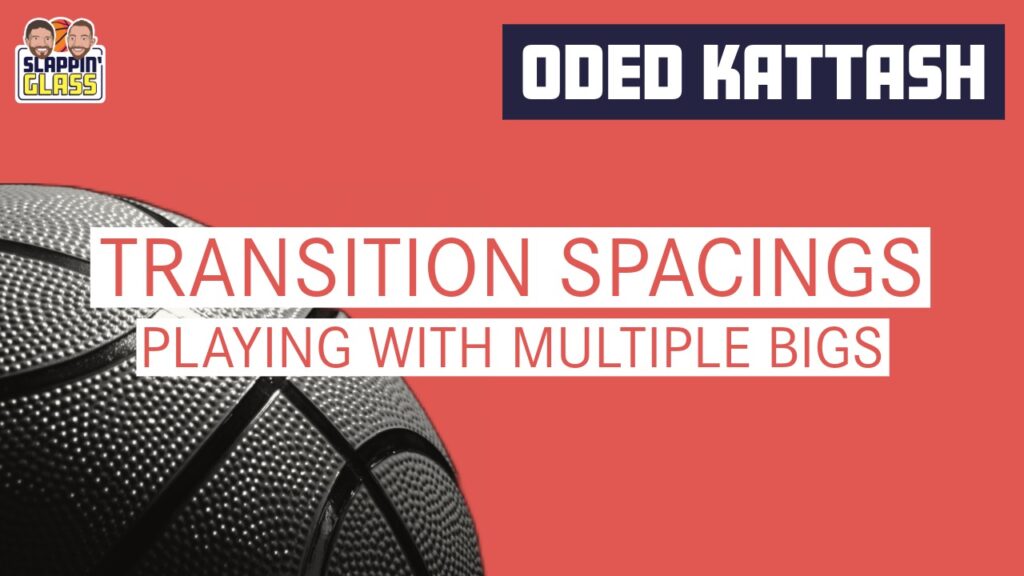This off-season, we’ve dedicated significant time on SGTV to studying and highlighting the benefits of “5 Out Offensive Spacing” and its various concepts. However, as we discussed in our podcast with Converse University Head Coach, Nick Pasqua, though it is increasing popular and effective, the 5 Out Offense also comes with its own set of challenges, particularly in creating double gaps for players to attack downhill. To expand our exploration of offensive spacing, today we turn our attention to Maccabi Tel Aviv Head Coach, Oded Kattash, and his “3 Out 2 In” transition flow concepts, which offer a different approach to transition spacing when two bigs share the court.
In today’s video breakdown and newsletter, we’ll examine how Coach Kattash spaces his two bigs based on different transition scenarios and the concepts that naturally flow out of each, including:
- Corners Filled Transition
- Empty Corner Transition
- Two Trailer Transition
Corners Filled Transition
In two of the three scenarios we’ll look at today, Maccabi Tel Aviv will flow into the halfcourt with the two corners filled. In this first scenario, one of the bigs has made an early rim run and so the offense initiates with a Drag Screen by the second big. This Drag Screen acts as the primary trigger, with the ballhandler and screener continuing their action until an advantage is created. Meanwhile, the corners hold their spacing, and the “partner big” mirrors the ballhandler to continuously create space for the roll, forcing the defense into long single-side tag situations.
Zooming In: The primary responsibility of the rim big is to read the ball, continuously following its movement and searching for gaps or pockets of space to be available for a pass or to execute a duck-in seal.
Zooming In 2.0: With the rim big mirroring the ball and the perimeter players holding the corners, Coach Kattash stretches the defense, making it challenging for them to close off the high paint. As shown above, the rim big’s re-adjustment pulls his defender out of the backside help. Meanwhile, with the corner player holding their position behind the ball, there is no one available to tag the roll without leaving the corner open for a skip pass and a potential three-pointer.
This defensive conundrum is a cornerstone of Coach Kattash’s spacing with two bigs. It forces the defense to choose between helping off the corner, which opens up potential three-point attempts and long closeouts, or, forcing the defensive rim big to manage two players in the paint…
Next Actions or Flow: For those of us who maybe don’t have the skilled bigs or trust our PG to attack this way right out of transition, the spacing and concepts here are easily transferrable into other offensive actions. For example, flowing into a “Euro Flow Motion” look is fairly simple by popping the trail big after the Drag Screen and having them play to a two man game DHO/PNR on the next side. The offensive big at the rim would then elevate up the slot and voila! You’re in Euro Flow Motion {🔒}.
Empty Corner Transition
When advancing up the court with an empty corner, maximizing space relies heavily on the ballhandler’s ability to drive the ball well below the free-throw line for the initial drag screen, which is set this time by the rim big.
Zooming In: By setting the on-ball screen below the free-throw line, the spacing takes away the ability of the defense to wall up or sit on the nail.
With the nail open, the ballhandler becomes a much greater threat coming off the empty drag screen, necessitating the defensive big’s attention. The next question for the defense is… who will help control the roller? This is where Coach Kattash’s spacing excels. With the second big positioned at the opposite elbow and the weakside perimeter player spaced just off the corner, the offense creates confusion as to who is responsible for rim protection.
Zooming In: As demonstrated above, the spacing makes it difficult for the perimeter defender to provide help, as they have to cover a long distance. Additionally, if the perimeter defender does pull in to help on the roll, the big at the elbow will need to “X” out to contest the skip pass. Technically, the short help rotation could come from the defensive big at the elbow, but doing so carries significant risk…
Next Actions or Flow: Referencing the example above, if Maccabi doesn’t play to either of the two bigs out of the empty drag screen, the alignment allows them to flow directly into their Step-Up Screen spacing and concepts. In this case, the ballhandler will hit the guard stationed in the deep middle third where they can then flow directly into a Reverse Ballscreen. This is where the offense shares similarities with the “Australia Reverse Offense” {🔒} we looked at earlier this year.
For much more on how Coach Kattash’s Two Big Offense flows so efficiently, including “Two Trailer Transition” concepts, become an SG+ Plus Member today!
